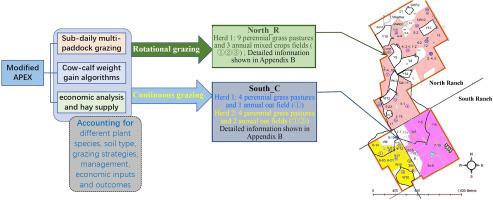Agricultural Systems ( IF 6.6 ) Pub Date : 2021-10-08 , DOI: 10.1016/j.agsy.2021.103287 Q.X. Fang 1 , R.D. Harmel 2 , L. Ma 3 , P.N.S. Bartling 3 , J.D. Derner 4 , J. Jeong 5 , J.R. Williams 5 , R.B. Boone 6

|
CONTEXT
Simulation tools are increasingly used to inform grazing management decisions by assessing livestock performance, as well as environmental and economic impacts. Ability to represent the grazing of multiple pastures (i.e., paddocks) that differ in soil, hydrology, vegetation, and management is critical for reliable grazing management decision support.
OBJECTIVE
The main objectives of this study were to: 1) modify APEX (Agricultural Policy/Environmental eXtender) for sub-daily grazing, cow-calf weight gain, and supplemental hay, and 2) evaluate the APEX modifications in terms of simulating biomass, calf weight gain, economic impacts of alternative cow-calf grazing management strategies.
METHODS
APEX was modified to enhance its ability to simulate alternative grazing management strategies by including sub-daily grazing among multiple paddocks, supplemental hay estimation, and optional simulation of cow-calf weight gain based either on energy or total digestible nutrients (TDN). Simulation results were evaluated against a 5-year experimental data set from Central Texas comparing multi-paddock rotational grazing and conventional continuous grazing.
RESULTS AND CONCLUSION
The modified APEX model adequately simulated the responses of vegetation biomass (coefficient of determination, R2 = 0.60–0.70), hay consumption (R2 = 0.94–0.95), calf weaning weight (R2 = 0.52–0.65), costs (R2 = 0.98), and profits (R2 = 0.89) to the two grazing treatments across years. Simulations with the energy-based weight gain algorithm showed more pronounced effects on above-ground biomass, whereas the TDN-based algorithm had a more pronounced weight gain response to forage intake and hay quality. No significant differences (p > 0.05) in biomass and calf weaning weight were observed between treatments across the years for measured data and for energy-based APEX simulation; however, the TDN-based algorithm simulated lower calf weaning weight in multi-paddock rotational grazing than in continuous grazing. Measured and simulated data also showed similar profits between the two grazing treatments, but total cost and gross return per ha were greater for continuous grazing.
SIGNIFICANCE
The model enhancements for sub-daily grazing, cow-calf weight gain, and supplemental hay improved the potential utility of APEX for assessing environmental and economic impacts of alternative grazing strategies at ranch scale.
中文翻译:

评估德克萨斯州中部替代牛犊放牧管理策略的 APEX 模型
语境
模拟工具越来越多地用于通过评估牲畜性能以及环境和经济影响来为放牧管理决策提供信息。能够表示土壤、水文、植被和管理不同的多个牧场(即围场)的放牧对于可靠的放牧管理决策支持至关重要。
客观的
本研究的主要目标是:1) 针对次日放牧、牛犊增重和补充干草修改 APEX(农业政策/环境扩展),以及 2) 在模拟生物量、犊牛体重增加,替代牛犊放牧管理策略的经济影响。
方法
APEX 进行了修改,以增强其模拟替代放牧管理策略的能力,包括在多个围场之间进行次日放牧、补充干草估计以及基于能量或总可消化营养素 (TDN) 的可选模拟牛犊增重。根据来自德克萨斯州中部的 5 年实验数据集对模拟结果进行了评估,该数据集比较了多牧场轮转放牧和传统连续放牧。
结果与结论
修正的 APEX 模型充分模拟了植被生物量(决定系数,R 2 = 0.60–0.70)、干草消耗量(R 2 = 0.94–0.95)、犊牛断奶体重(R 2 = 0.52–0.65)、成本(R 2 = 0.98),以及 跨年两种放牧处理的利润 (R 2 = 0.89)。基于能量的增重算法的模拟显示对地上生物量的影响更显着,而基于 TDN 的算法对草料摄入量和干草质量的增重响应更为明显。无显着差异 ( p > 0.05) 在测量数据和基于能量的 APEX 模拟中,在多年的处理之间观察到生物量和犊牛断奶重量;然而,与连续放牧相比,基于 TDN 的算法在多牧场轮转放牧中模拟了较低的犊牛断奶重量。测量和模拟数据也显示两种放牧处理之间的利润相似,但连续放牧的总成本和每公顷总回报更高。
意义
次日放牧、牛犊增重和补充干草的模型增强改进了 APEX 在评估牧场规模替代放牧策略的环境和经济影响方面的潜在效用。



























 京公网安备 11010802027423号
京公网安备 11010802027423号